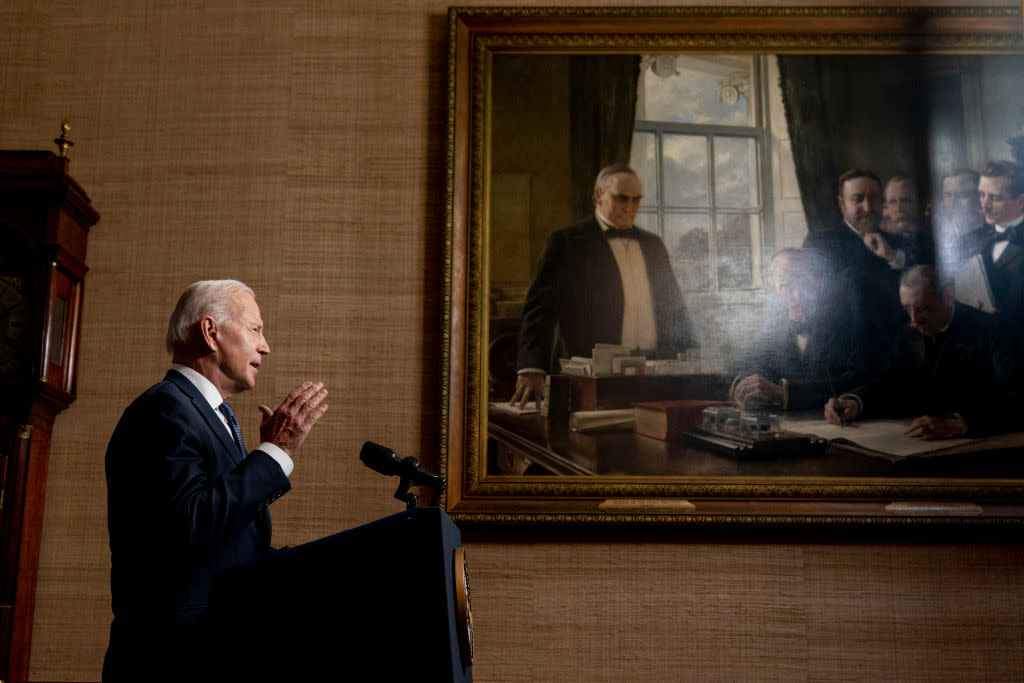President Biden Made the Right Choice to Withdraw from Afghanistan

- Oops!Something went wrong.Please try again later.
U.S. President Joe Biden speaks from the Treaty Room in the White House about the withdrawal of U.S. troops from Afghanistan on April 14, 2021 in Washington, DC. President Biden announced his plans to pull all remaining U.S. troops out of Afghanistan by September 11, 2021 in a final step towards ending America’s longest war. Credit - Andrew Harnik-Pool/Getty Images
President Biden made a commendable decision to end the war in Afghanistan.
It wasn’t an easy decision. But it was the kind of decision that leaders make when subordinates don’t agree, and those choices are often the “least bad” option.
And it was an overdue decision to those of us who fought the war.
As the Commanding Officer of SEAL Team TWO in 2012, I ran all special operations in southeastern Afghanistan, on one of several tours in the country. “Nations are really good at starting wars and really bad at ending them,” I told a reporter at the time who embedded with us in a remote, restive Afghan village. “There will always be a political settlement needed.”
For 215 days of our 300-day deployment at least one unit was engaged in direct, daily combat with the Taliban, and I approved air-to-ground strikes over 1,100 times. We, like every unit, improved security and governance as the U.S. invested heavily in Afghan military forces and civilian institutions. We, like every unit, then rotated out of the country.
Nine years later, with no clear political settlement, in making the decision to withdraw President Biden avoided several mistakes that enabled the previous decades of stalemate.
Most notably, President Biden made the decision in opposition to the uniformed leadership’s recommendation to maintain a small presence in Afghanistan, as widely reported. That advice is predictable and understandable. There is a systemic and unconscious bias where wartime leaders are more revered than peacetime leaders, optionality is overvalued, and it is difficult to exit from long held positions. But finally after two decades of dedication from our nation’s uniformed leadership, we begin a path to exit with a far more capable Afghan military and with minimized transnational threats from the region. This is not a loss.
Second, the cost-benefit analysis of maintaining the status quo in Afghanistan neglected to consider opportunity cost. Said differently, the value of simplifying our national security deployment footprint and enabling recovery and readiness for what we can’t see next is a difficult value to assess and easily overlooked. Not ironically, President Eisenhower prioritized resting and refitting our troops because General Eisenhower saw first-hand the true and full cost of prolonged combat. Transformation must equal simplification, agility, and ever-growing power. President Biden just echoed Eisenhower’s wise choice.
Third, the wrong metrics can distract logic. Keeping 2,500 troops in Afghanistan sounds small and easy. It’s not. The right metric would assess the total cost of those 2,500 troops. Dedicated intelligence assets, logistics, and staff bandwidth consumed across CENTCOM, the Joint Staff, and service providers are multiples of those 2,500 and have their own opportunity cost. The financial cost of contractors, supplies, and aid could be used to strengthen other parts of the military around the world to prepare for more likely security threats than a resurgent Taliban.
The fourth challenge—something military leaders especially struggle with—is the impossibility of applying the principle of sunk costs to human life. We all know theoretically that “sunk costs are sunk,” but when those costs are friends and teammates, it isn’t easy to walk away. There’s no way ever to quantify the loss of over 2,200 American servicemen and women, 3,800 American contractors, and 100,000 Afghans over two decades. The stoic philosophers like Epictetus and Aurelius taught to detach without being vacuous but that isn’t always the easiest advice to follow. Like all SEALs and service members of my era, I’ve buried far too many friends. We best honor them by making a stoic and intelligent choice today, not by sacrificing and investing more in a mission no longer central to our national security.
In 20 years, we’ve learned many painful lessons. We’ve learned that the Afghan government and military will never begin to counterbalance the Taliban if a significant international presence remains. We’ve learned that the Taliban is not a transnational threat. We’ve identified the real and pressing transnational threats, like al Qaeda and ISIS, that too easily populate numerous other regions and safe havens, which our military rightly continues to pursue. We can’t cover all the ground where extremists may inhabit. We have to deal with extremists where and when they amass.
In 2021, after taking the best military and civilian advice into account, President Biden made the difficult but net-best decision that this battle is no longer in Afghanistan. It’s also reassuring to see trust, communication, and clarity engender respect and a one-team approach to national unity.
